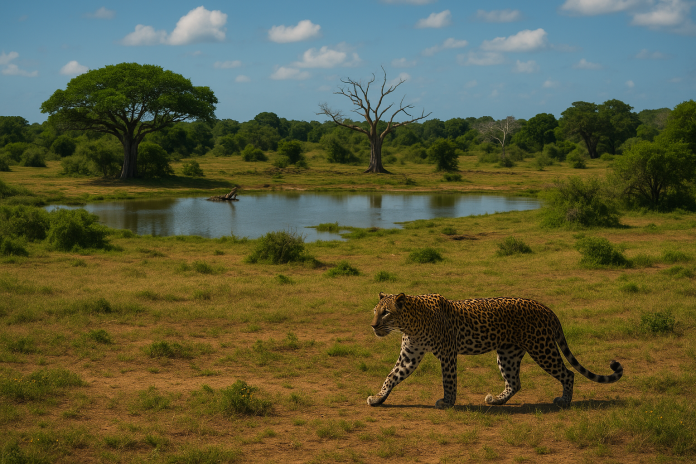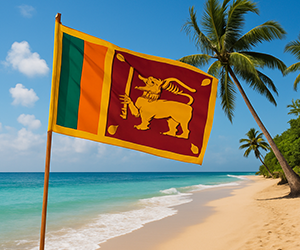Introduction to Yala National Park
Located in the southeastern region of Sri Lanka, Yala National Park is the most visited and second-largest national park on the island. Covering an area of over 979 square kilometers, Yala is famed for its diverse ecosystems, rich biodiversity, and high density of Sri Lankan leopards. As a flagship destination for wildlife tourism in Sri Lanka, Yala offers an unforgettable safari experience that draws nature lovers and adventurers from around the globe.
History and Significance
Yala was originally designated as a wildlife sanctuary in 1900 and became a national park in 1938, making it one of the oldest protected areas in Sri Lanka. Historically, the area has deep roots in both Buddhist and Hindu cultures, with ancient temples and ruins dotting the park’s interior. It was once a hunting ground for British colonial elites but now stands as a symbol of conservation and eco-tourism in Sri Lanka.
Geographical Location and Terrain
Yala lies within the Southern and Uva Provinces, bordering the Indian Ocean. The park is characterized by a mixture of ecosystems, including dry monsoon forests, grasslands, wetlands, sandy beaches, and rocky outcrops. These varied habitats support a wide array of plant and animal life, making each safari drive a unique adventure.
The park is divided into five blocks, but Block I is the most accessible and popular among tourists. This section alone is home to the highest density of leopards per square kilometer in the world.
Wildlife in Yala National Park
Mammals
Yala is a haven for wildlife enthusiasts due to its incredible variety of mammals. Some of the most sought-after species include:
- Sri Lankan Leopard (Panthera pardus kotiya): The star attraction and a subspecies endemic to Sri Lanka. Best sightings occur in Block I.
- Sri Lankan Elephant: Often seen in herds around waterholes.
- Sloth Bear: A shy and elusive resident, seen mainly during the fruiting season.
- Spotted Deer, Sambar Deer, Wild Boar, Toque Macaque, and Golden Jackal.
Birds
Yala is a birdwatcher’s paradise, hosting over 215 bird species, including:
- Peacocks, Painted Storks, Eagles, and Bee-eaters
- Endemics like the Sri Lanka Junglefowl (the national bird)
- Migratory birds during the northern winter, especially near lagoons and wetlands
Reptiles and Amphibians
Yala also supports a variety of reptiles and amphibians, including:
- Mugger Crocodile and Saltwater Crocodile
- Monitor Lizards, Indian Cobra, Russell’s Viper
- Various frogs, skinks, and geckos
Flora and Habitats
The park’s vegetation varies from dry deciduous forests to scrublands, marshes, and coastal lagoons. Common plant species include:
- Palu (Manilkara hexandra)
- Weera (Drypetes sepiaria)
- Kumbuk (Terminalia arjuna)
- Thorny shrubs, medicinal herbs, and aquatic plants
These diverse ecosystems not only support wildlife but also play a vital role in climate regulation and water purification.
Safari Experience in Yala
Best Time to Visit
- Dry Season (February to June) is ideal for wildlife sightings as animals gather near waterholes.
- The park is closed in September for maintenance and rejuvenation.
Safari Types
- Jeep Safaris: The most common and recommended way to explore the park. Available for morning, evening, or full-day sessions.
- Private Tours: Great for photography enthusiasts and those seeking personalized experiences.
What to Expect on a Safari
Expect early morning starts, bumpy trails, and the thrill of spotting wild animals in their natural habitat. Most tours include:
- Professional naturalist guides
- Binoculars and field guides
- Refreshments and occasional picnic stops
Rules and Responsible Tourism
To protect the park’s fragile ecosystem, it is crucial to follow guidelines:
- Do not feed animals or leave trash behind
- Keep noise levels low
- Stay inside the vehicle at all times
- Support eco-certified tour operators
Accommodation Options
From luxury resorts to eco-lodges and budget-friendly guesthouses, Yala offers a range of accommodations:
- Cinnamon Wild Yala – A luxury resort bordering the park
- Jetwing Yala – Beachfront eco-resort with modern amenities
- Yala National Park Bungalows – Operated by the Department of Wildlife for a rustic experience
Many accommodations offer package deals including safaris, meals, and transport.
Nearby Attractions
Yala is surrounded by several other must-visit spots:
- Kataragama Temple – A multi-religious sacred site
- Sithulpawwa Rajamaha Viharaya – An ancient Buddhist monastery inside the park
- Bundala National Park – A Ramsar wetland and bird sanctuary nearby
- Kirinda Beach – A scenic coastal spot with a historical temple
Photography Tips
- Use long lenses (200mm or more) for distant wildlife
- Early morning or late afternoon light offers the best conditions
- Capture not just animals but landscapes and interactions
- Be patient and ready at all times
Yala National Park for Families
Yala is also family-friendly with the right planning:
- Choose half-day safaris for young children
- Pack snacks, water, and sun protection
- Educate children about wildlife and conservation
Conservation Challenges
Yala faces challenges like illegal poaching, habitat encroachment, and over-tourism. Conservationists are working on:
- Increasing awareness and education
- Research and monitoring of leopard populations
- Community-based eco-tourism initiatives
Conclusion
Yala National Park is not just a safari destination—it’s a window into Sri Lanka’s untamed beauty. With its diverse wildlife, enchanting landscapes, and rich history, it’s a must-visit for anyone looking to experience the wild heart of the island.
Whether you’re a seasoned wildlife photographer, a first-time visitor, or a curious explorer, Yala promises adventure, inspiration, and a deep connection to nature. Plan your trip responsibly, respect the wild, and let Yala leave you with memories to last a lifetime.




